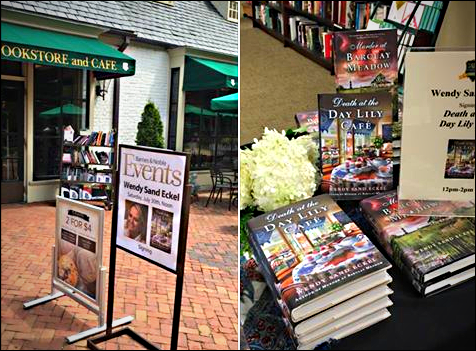From The Algonkian Study Guide
PLOTTING AND STORY DEVICES
For our purposes here, we define the novel as a long and interesting story that must make sense, no room for artifice or clunkiness, only phenomenal yet natural flow. During the course of pathing plot and story, the crafty author employs a variety of devices to smooth the flow, deliver necessary information, create a pause in the action, and more. Having knowledge of these methods in advance allows the author to storyboard with more creative flexibility, to push forward past problems that would otherwise confound and frustrate the inexperienced writer.
No Verisimilitude Without "Masking" : Foreshadow, Aftermath, Discussion, and Repercussion Application
Certain events must take place to move the novel forward, and often the author must use skillful storytelling technique to produce verisimilitude, i.e., to make the occurrence of the event seem natural rather than too convenient or contrived. "Masking" refers to the sum of this technique, the cumulative effect rendering a necessary yet potentially awkward event believable. Proper utilization of this indispensable technique allows the author more freedom to explore the introduction of unusual and/or surprising events and/or endings.
In Nabokov's Lolita, the wife of Humbert conveniently dies so that Humbert can proceed with his plans to seclude himself with Lolita:
First, the event is foreshadowed - Humbert receives a phone call from a neighbor stating that something has happened to his wife. Next, (beginning a new chapter) Humbert goes outside and witnesses the aftermath carnage of the accident - the scene is complex with objects and nearly surreal in portrayal. The police show him the body, he observes the details of it, etc. All of this lends credibility to the event. A few pages later, as a repercussion of the event occurs: a discussion ensues with a man who arrives to hash over accident details with Humbert—the question of the event's verisimilitude is settled.
____________
Sample of Assignments Emailed to Workshop Attendees
PLOTTING AND STORY DEVICES
For our purposes here, we define the novel as a long and interesting story that must make sense, no room for artifice or clunkiness, only phenomenal yet natural flow. During the course of pathing plot and story, the crafty author employs a variety of devices to smooth the flow, deliver necessary information, create a pause in the action, and more. Having knowledge of these methods in advance allows the author to storyboard with more creative flexibility, to push forward past problems that would otherwise confound and frustrate the inexperienced writer.
No Verisimilitude Without "Masking" : Foreshadow, Aftermath, Discussion, and Repercussion Application
Certain events must take place to move the novel forward, and often the author must use skillful storytelling technique to produce verisimilitude, i.e., to make the occurrence of the event seem natural rather than too convenient or contrived. "Masking" refers to the sum of this technique, the cumulative effect rendering a necessary yet potentially awkward event believable. Proper utilization of this indispensable technique allows the author more freedom to explore the introduction of unusual and/or surprising events and/or endings.
In Nabokov's Lolita, the wife of Humbert conveniently dies so that Humbert can proceed with his plans to seclude himself with Lolita:
First, the event is foreshadowed - Humbert receives a phone call from a neighbor stating that something has happened to his wife. Next, (beginning a new chapter) Humbert goes outside and witnesses the aftermath carnage of the accident - the scene is complex with objects and nearly surreal in portrayal. The police show him the body, he observes the details of it, etc. All of this lends credibility to the event. A few pages later, as a repercussion of the event occurs: a discussion ensues with a man who arrives to hash over accident details with Humbert—the question of the event's verisimilitude is settled.
____________
Sample of Assignments Emailed to Workshop Attendees
For
this event you must purchase and read, or re-read "One Flew Over The
Cuckoo's Nest" by Ken Kesey and "The Great Gatsby" by Fitzgerald. Both
make important and fundamental points concerning plot structure, theme,
dramatic complication, scene construction, narrative composition, and
more. Both are utilized in the Algonkian Study Guide, along with other
important works. We cannot overstress the importance of this.
For your first assignment, go to your nearest library or book superstore. Read the first ten pages of at least five new literary novels (no genre, i.e, SF, mystery, etc.). Once you've spent a few hours, take out a laptop, or sheet of paper, and note bullet by bullet precisely what the author did within those first ten pages to make the protagonist appear sympathetic, original and interesting. Also, note how the information was delivered in "the hook" of the novel. Was the author telling us, or showing us the character's qualities in a vivid scene?
For your second assignment, examine the book jacket of each novel. Write the book jacket you would like to see for your novel (see your pitch model assignment upcoming). Ask yourself after you write it: WILL THIS MAKE SOMEONE WANT TO BUY MY BOOK? And if so, why? Note: limit the number of words to the average number you count on the jackets. Try to limit to 150-200 words.
____________________________________
Please use the following examples as models for your agent pitch session. Keep your pitch to 150-200 words, no more than a minute. Have the pitch written before the conference begins. Note that the pitch is a diagnostic tool to determine the strong and weak points of your novel. If you do not have enough novel for a pitch, then no problem. Now is the time to start thinking about it!
Take special note of dramatic tension and plot points, rising action, character qualities.
"The English Teacher" by Lily King:
(HOOK - the entire first paragraph) Fifteen years ago Vida Avery arrived alone and pregnant at elite Fayer Academy. She has since become a fixture and one of the best English teachers Fayer has ever had. By living on campus, on an island off the New England coast, Vida has cocooned herself and her son, Peter, from the outside world and from an inside secret. (SCENE SET) For years she has lived largely through the books she teaches, but when she accepts the impulsive marriage proposal of ardent widower Tom Belou, the prescribed life Vida has constructed is swiftly dismantled. (PLOT POINT creates COMPLICATIONS or DRAMATIC TENSION)
Peter, however, welcomes the changes. Excited to move off campus, eager to have siblings at last, Peter anticipates a regular life with a "normal" family. But the Belou children are still grieving, and the memory of their recently dead mother exerts a powerful hold on the house. As Vida begins teaching her signature book, Tess of the D'Urbervilles, a nineteenth-century tale of an ostracized woman and social injustice, its themes begin to echo eerily in her own life and Peter sees that the mother he perceived as indomitable is collapsing and it is up to him to help. (SECOND PLOT POINT creates MAJOR COMPLICATION and RISING ACTION leading to CLIFFHANGER: will Peter save his mother?)
Another example from "Close Case" by Alafair Burke:
Investigating the brutal murder of a hotshot journalist, Samantha Kincaid finds herself caught in the middle of an increasingly personal and potentially dangerous struggle between Portland's police and the DA's office.(HOOK, SCENE SET, SUBPLOT COMPLICATION).
For Deputy District Attorney Samantha Kincaid's thirty-second birthday, she gets an unusual gift: a homicide call out. (PLOT POINT begins MAJOR COMPLICATION: solve the crime) The crime scene: the elite Hillside neighborhood in Portland, Oregon. The victim: hotshot investigative reporter Percy Crenshaw, who has been bludgeoned to death in his carport.
Tensions in the city have been running high. The previous week, a police officer shot and killed an unarmed mother of two in what he claims was self-defense; in the aftermath, protestors have waged increasingly agitated anti-police protests. Crenshaw's death, it seems, is not unrelated: within a matter of hours, police arrest two young men who appear to have embarked on a crime spree in the aftermath of the protests. The case looks straightforward, especially when one of the suspects confesses. But then the man recants, claiming coercive police tactics, and Samantha finds herself digging for more evidence. (PLOT POINT, RISING ACTION, MORE SUB-COMPLICATIONS)
Following Crenshaw's steps, her search leads her through an elaborate maze of connections between the city's drug trade and officers in the bureau's north precinct. Samantha's pursuit of the truth puts her in the middle of city political battles and on the outs with the cops, including her new live-in boyfriend, Detective Chuck Forbes. Worse yet, the path left by Crenshaw could lead Samantha to the same fatal end.(CLIFFHANGER: will Samantha save her own life, solve the murder in the process, and later, recover her love interest? THREE QUESTIONS BEGGED!)_____
Now, go and write the PITCH for your novel. And please, take your time!
Once done, put it aside for two days, then read it and ask yourself this question:
WILL THIS MAKE SOMEONE WANT TO BUY MY BOOK?
For your first assignment, go to your nearest library or book superstore. Read the first ten pages of at least five new literary novels (no genre, i.e, SF, mystery, etc.). Once you've spent a few hours, take out a laptop, or sheet of paper, and note bullet by bullet precisely what the author did within those first ten pages to make the protagonist appear sympathetic, original and interesting. Also, note how the information was delivered in "the hook" of the novel. Was the author telling us, or showing us the character's qualities in a vivid scene?
For your second assignment, examine the book jacket of each novel. Write the book jacket you would like to see for your novel (see your pitch model assignment upcoming). Ask yourself after you write it: WILL THIS MAKE SOMEONE WANT TO BUY MY BOOK? And if so, why? Note: limit the number of words to the average number you count on the jackets. Try to limit to 150-200 words.
____________________________________
Please use the following examples as models for your agent pitch session. Keep your pitch to 150-200 words, no more than a minute. Have the pitch written before the conference begins. Note that the pitch is a diagnostic tool to determine the strong and weak points of your novel. If you do not have enough novel for a pitch, then no problem. Now is the time to start thinking about it!
Take special note of dramatic tension and plot points, rising action, character qualities.
"The English Teacher" by Lily King:
(HOOK - the entire first paragraph) Fifteen years ago Vida Avery arrived alone and pregnant at elite Fayer Academy. She has since become a fixture and one of the best English teachers Fayer has ever had. By living on campus, on an island off the New England coast, Vida has cocooned herself and her son, Peter, from the outside world and from an inside secret. (SCENE SET) For years she has lived largely through the books she teaches, but when she accepts the impulsive marriage proposal of ardent widower Tom Belou, the prescribed life Vida has constructed is swiftly dismantled. (PLOT POINT creates COMPLICATIONS or DRAMATIC TENSION)
Peter, however, welcomes the changes. Excited to move off campus, eager to have siblings at last, Peter anticipates a regular life with a "normal" family. But the Belou children are still grieving, and the memory of their recently dead mother exerts a powerful hold on the house. As Vida begins teaching her signature book, Tess of the D'Urbervilles, a nineteenth-century tale of an ostracized woman and social injustice, its themes begin to echo eerily in her own life and Peter sees that the mother he perceived as indomitable is collapsing and it is up to him to help. (SECOND PLOT POINT creates MAJOR COMPLICATION and RISING ACTION leading to CLIFFHANGER: will Peter save his mother?)
Another example from "Close Case" by Alafair Burke:
Investigating the brutal murder of a hotshot journalist, Samantha Kincaid finds herself caught in the middle of an increasingly personal and potentially dangerous struggle between Portland's police and the DA's office.(HOOK, SCENE SET, SUBPLOT COMPLICATION).
For Deputy District Attorney Samantha Kincaid's thirty-second birthday, she gets an unusual gift: a homicide call out. (PLOT POINT begins MAJOR COMPLICATION: solve the crime) The crime scene: the elite Hillside neighborhood in Portland, Oregon. The victim: hotshot investigative reporter Percy Crenshaw, who has been bludgeoned to death in his carport.
Tensions in the city have been running high. The previous week, a police officer shot and killed an unarmed mother of two in what he claims was self-defense; in the aftermath, protestors have waged increasingly agitated anti-police protests. Crenshaw's death, it seems, is not unrelated: within a matter of hours, police arrest two young men who appear to have embarked on a crime spree in the aftermath of the protests. The case looks straightforward, especially when one of the suspects confesses. But then the man recants, claiming coercive police tactics, and Samantha finds herself digging for more evidence. (PLOT POINT, RISING ACTION, MORE SUB-COMPLICATIONS)
Following Crenshaw's steps, her search leads her through an elaborate maze of connections between the city's drug trade and officers in the bureau's north precinct. Samantha's pursuit of the truth puts her in the middle of city political battles and on the outs with the cops, including her new live-in boyfriend, Detective Chuck Forbes. Worse yet, the path left by Crenshaw could lead Samantha to the same fatal end.(CLIFFHANGER: will Samantha save her own life, solve the murder in the process, and later, recover her love interest? THREE QUESTIONS BEGGED!)_____
Now, go and write the PITCH for your novel. And please, take your time!
Once done, put it aside for two days, then read it and ask yourself this question:
WILL THIS MAKE SOMEONE WANT TO BUY MY BOOK?
_____________________________________________________

 In
keeping with their spirit, and the spirit of the place, you can be as
goal-focused at the retreat, or as hesitant in approach as you wish. You
can talk novel, memoir, or short story publication with us, show us your manuscript,
improve your skills, clear your head, have your work read by our onsite
writer mentors, whatever you wish, whatever helps you grow and find your
vision as a writer. You tell us ahead of time via the
In
keeping with their spirit, and the spirit of the place, you can be as
goal-focused at the retreat, or as hesitant in approach as you wish. You
can talk novel, memoir, or short story publication with us, show us your manuscript,
improve your skills, clear your head, have your work read by our onsite
writer mentors, whatever you wish, whatever helps you grow and find your
vision as a writer. You tell us ahead of time via the 
